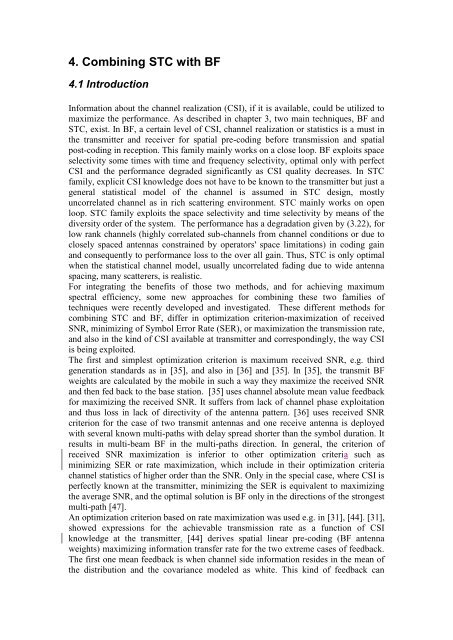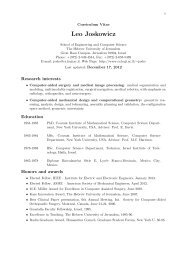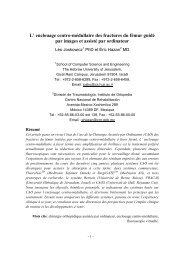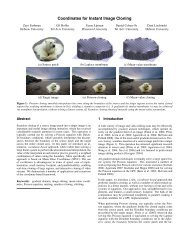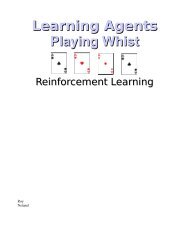TEL AVIV UNIVERSITY Gaddi Blumrosen
TEL AVIV UNIVERSITY Gaddi Blumrosen
TEL AVIV UNIVERSITY Gaddi Blumrosen
Create successful ePaper yourself
Turn your PDF publications into a flip-book with our unique Google optimized e-Paper software.
4. Combining STC with BF<br />
4.1 Introduction<br />
Information about the channel realization (CSI), if it is available, could be utilized to<br />
maximize the performance. As described in chapter 3, two main techniques, BF and<br />
STC, exist. In BF, a certain level of CSI, channel realization or statistics is a must in<br />
the transmitter and receiver for spatial pre-coding before transmission and spatial<br />
post-coding in reception. This family mainly works on a close loop. BF exploits space<br />
selectivity some times with time and frequency selectivity, optimal only with perfect<br />
CSI and the performance degraded significantly as CSI quality decreases. In STC<br />
family, explicit CSI knowledge does not have to be known to the transmitter but just a<br />
general statistical model of the channel is assumed in STC design, mostly<br />
uncorrelated channel as in rich scattering environment. STC mainly works on open<br />
loop. STC family exploits the space selectivity and time selectivity by means of the<br />
diversity order of the system. The performance has a degradation given by (3.22), for<br />
low rank channels (highly correlated sub-channels from channel conditions or due to<br />
closely spaced antennas constrained by operators' space limitations) in coding gain<br />
and consequently to performance loss to the over all gain. Thus, STC is only optimal<br />
when the statistical channel model, usually uncorrelated fading due to wide antenna<br />
spacing, many scatterers, is realistic.<br />
For integrating the benefits of those two methods, and for achieving maximum<br />
spectral efficiency, some new approaches for combining these two families of<br />
techniques were recently developed and investigated. These different methods for<br />
combining STC and BF, differ in optimization criterion-maximization of received<br />
SNR, minimizing of Symbol Error Rate (SER), or maximization the transmission rate,<br />
and also in the kind of CSI available at transmitter and correspondingly, the way CSI<br />
is being exploited.<br />
The first and simplest optimization criterion is maximum received SNR, e.g. third<br />
generation standards as in [35], and also in [36] and [35]. In [35], the transmit BF<br />
weights are calculated by the mobile in such a way they maximize the received SNR<br />
and then fed back to the base station. [35] uses channel absolute mean value feedback<br />
for maximizing the received SNR. It suffers from lack of channel phase exploitation<br />
and thus loss in lack of directivity of the antenna pattern. [36] uses received SNR<br />
criterion for the case of two transmit antennas and one receive antenna is deployed<br />
with several known multi-paths with delay spread shorter than the symbol duration. It<br />
results in multi-beam BF in the multi-paths direction. In general, the criterion of<br />
received SNR maximization is inferior to other optimization criteria such as<br />
minimizing SER or rate maximization, which include in their optimization criteria<br />
channel statistics of higher order than the SNR. Only in the special case, where CSI is<br />
perfectly known at the transmitter, minimizing the SER is equivalent to maximizing<br />
the average SNR, and the optimal solution is BF only in the directions of the strongest<br />
multi-path [47].<br />
An optimization criterion based on rate maximization was used e.g. in [31], [44]. [31],<br />
showed expressions for the achievable transmission rate as a function of CSI<br />
knowledge at the transmitter. [44] derives spatial linear pre-coding (BF antenna<br />
weights) maximizing information transfer rate for the two extreme cases of feedback.<br />
The first one mean feedback is when channel side information resides in the mean of<br />
the distribution and the covariance modeled as white. This kind of feedback can


